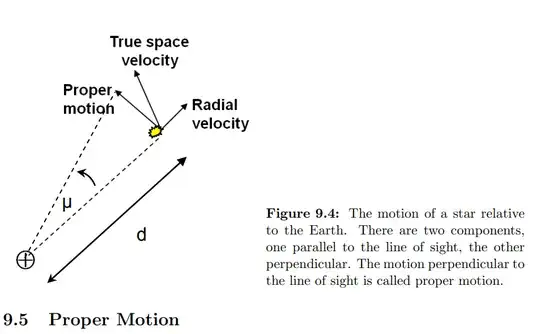If $\mu$ is the proper motion of a star in arcseconds per year, and $d$ is the star’s distance from us, then the transverse speed, $v_t$ will be $$v_t=d\sin\mu$$ For small motions (assumed for this question) $\sin\mu\approx \mu$
Barnard’s star has a measured parallax of $0.55\, \rm{arcsec}$. Barnard’s star also has a proper motion of $10.3$ arcsec per year. What component of the star’s velocity relative to the Sun can be deduced from the proper motion? Calculate this component, in $\rm{kms^{−1}}$.
This is the way I thought the transverse speed should be calculated:
Firstly, $d$, can be determined through the trigonometric parallax, $p$: $$d(\rm{pc})=\frac{1}{p(\rm{arcsec})}$$
For a parallax of $0.55\, \rm{arcsec}$
$$d=\frac{1}{0.55}\approx 1.8 {\rm\, pc}$$ Using the fact that $1\,\rm{pc}=3.1\times 10^{16}\,\rm{m}$ & $1\, \rm{yr}=3\times 10^7\,\rm{s}$ $$\begin{align}v_t&=d\mu \\&=1.8 \,\rm{pc}\times \frac{3.1\times 10^{16}\rm{m}}{pc}\times\frac{10.3 \,\color{green}{\rm{arcsec}}}{3\times 10^7\,\rm{s}}\\&=\frac{1.8\times 3.1\times 10^{16}\times 10.3\,\rm{m}}{3\times 10^7\,\rm{s}}\\&\approx 1.92\times 10^{10}\,\rm{m\,s^{-1}}\\&=1920\times 10^7 \,\rm{km\,s^{-1}} \end{align}$$
The part marked green I have omitted since it is dimensionless.
Before asking this I searched for an answer and found this similar question which also omitted a dimensionless unit (which was radians in their case).
The correct answer is
At the distance of Barnard’s star ($1.8 \,\rm{pc}$), $\bbox[yellow]{{\text{an angle of} \, 10.3 \, \rm{arcsec}\, \text{corresponds to}\, 1.8 \times 10.3 \, \rm{AU}}}$, or $1.8 \times 10.3 \times 1.5 × 10^{11}\,\rm{m}$. This is the distance covered in $1$ year, or $\sim 3 \times 10^7\,\rm{s}$, yielding a velocity of about $90 \, \rm{km\, s^{−1}}$.
I have highlighted in yellow the part I do not understand in the solution. Why does $\bbox[yellow,5px,border:2px solid red]{{\text{an angle of} \, 10.3 \, \rm{arcsec}\, \text{correspond to}\, 1.8 \times 10.3 \, \rm{AU}}}\,$?
Specifically, I don't understand why the $\rm {AU}$ comes into this (I thought the distances were in $\rm{pc}$, not $\rm{AU}$).
